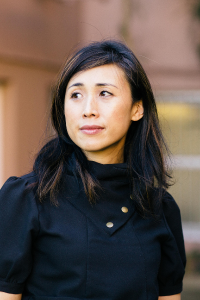
As we approach International Day of Women and Girls in Science (February 11), Dr. Sumer Seiki, associate professor, shares details on past and upcoming projects and ways educators can inspire an interest in science.
***
 Dr. Seiki considers herself a botanist. Along with a white lab coat, she also uses gardening gloves. Her passion for biology is rooted in an appreciation for plants and gardening.
Dr. Seiki considers herself a botanist. Along with a white lab coat, she also uses gardening gloves. Her passion for biology is rooted in an appreciation for plants and gardening.
“I have always loved plants; it was kind of a family thing,” says Dr. Seiki with a smile. “Some of my fondest memories were with my grandmothers in their gardens. Both of my grandmothers were incredible gardeners.”
When her grandparents immigrated to California, USA, it was at a time where there were many Anti-Asian race-based exclusion acts. They had to become resourceful with the small plot of land and providing food for a big family.
“She really was a genius. She fully utilized this small, half the size of a bedroom, garden, and taught herself what she could grow during the summer and what she could store in the cellar and feed the family over the winter. She had this calendar in her head and body.”
When Dr. Seiki would stay with them during school breaks, she would watch her grandmothers garden, enjoy digging in the Earth, picking the different fruits and vegetables to make fresh and delicious meals.
“I went to post-secondary school knowing that plants were magical and amazing, and just knew that’s what I wanted to study.”
Q&A With Dr. Seiki
What are some ways educators can inspire students to be interested in science?
I would encourage educators to start by helping kids love organisms (plants, animals, etc.) and the Earth. As a science teacher, some of what we’re doing is helping them learn about the world around them — and all the mysteries and wonders that go along with it. I think helping students understand the relationships they have with the different ecosystems is really powerful teaching.
Science is used by every culture. Every culture has science knowers and actors, even though they themselves might not realize it. Like my grandmothers, who were expert botanists. I think educators helping their students see their families as knowers and users of science, helps them locate themselves in science knowledge production and use. It becomes less abstract and more apparent in day-to-day activities, like making dinner by boiling water for pasta. They’ll see that they do, and can, make scientific decisions.
What are some examples of projects you have participated in?
After working in the Smithsonian Museum in Washington DC, I was inspired by a number of different exhibits, lectures and books. There was one phenomenal installation by an artist, Jean Shin, who also came to the museum for a lecture to explain her exhibits. When you walked into her exhibit room, there was nothing on the lower walls and as you walk further in and look up you see that the entire ceiling is connected by these sweaters and each sweater is unraveled and it’s connected to all the people that owned the sweaters in relation to each other. It was a physical installation on the relationships of a small group of people. It was like an ecosystem.
Knowing, and experiencing, how powerful an installation can be for learning influenced ideas I had for my own classroom installations. I built different deciduous forests and ocean ecosystems while working with pre-service teachers. After a few years, I knew I had to take an installation to a classroom with children.
I had one particularly dynamic mentor teacher that I had been working with, and so I asked if I could use her second-grade classroom for this rainforest ecosystem installation project. I assigned the student teachers in my science methods course to build different parts of a rainforest. We came to the school and set up the rainforest overnight so it would be a big reveal for the children in the morning. We were standing on desks and throwing vines everywhere, a giant six-foot tree in middle of the room and there was something on every wall.
The next morning, I went to the school to see the students’ reaction of walking into their classroom. The teacher unlocks the door and let them in as she usually does. The students come running in and stop in their tracks. They’re silent. Then they started excitedly yelling and bouncing around the classroom pointing at all the different animals and plants.
The installation became a real conduit for learning. Over the course of a month, they used it in a number of different ways, including giving all the other classrooms in their school tours and educating them on the ecosystems in a rainforest.
Learn more about her Urban Classroom Rainforest Project by reading her published paper with coauthor Dr. Pennie Gray.
What are some projects you currently working on?
One project I’m currently working on is a Syilx and Okanagan Native Seed Garden — a living library. The Okanagan is home to rich biodiversity, and with climate change, and urban sprawl, we know that we’ve lost and are at risk of losing many different species. As a global citizen, we need to protect these species. These amazing treasures. The seed garden is one way to create a living museum of organisms that are Indigenous to the area.